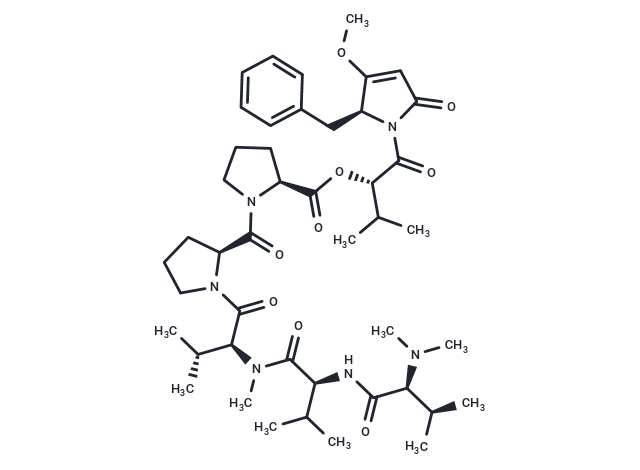Shopping Cart
- Remove All
 Your shopping cart is currently empty
Your shopping cart is currently empty

Dolastatin 15, a depsipeptide derived from Dolabella auricularia, is a potent antimitotic agent structurally related to the anti-tubulin agent Dolastatin 10. Dolastatin 15 can be used as an ADC cytotoxin and it induces cell cycle arrest and apoptosis in multiple myeloma cells.

| Pack Size | Price | Availability | Quantity |
|---|---|---|---|
| 100 mg | Inquiry | Backorder | |
| 500 mg | Inquiry | Backorder |
| Description | Dolastatin 15, a depsipeptide derived from Dolabella auricularia, is a potent antimitotic agent structurally related to the anti-tubulin agent Dolastatin 10. Dolastatin 15 can be used as an ADC cytotoxin and it induces cell cycle arrest and apoptosis in m |
| In vitro | Dolastatin 15 shows growth inhibitory activity against all four SCLC cell lines (NCI-H69, NCI-H82, NCI-H345, NCI-H446) (IC50: 0.039-28.8 nM), which were 2.7-9.2-fold higher than the values for dolastatin 10. Dolastatin 15 induces cell cycle arrest at the G2/M phase followed by apoptosis in various human myeloma cell lines (RPMI8226, U266, and IM9) and it also induces apoptosis of myeloma cells via activation of both mitochondrial- and Fas (CD95)/Fas-L (CD95-L)-mediated pathways [2]. All four SCLC cell lines underwent G2/M arrest within 24 hours of exposure to dolastatin 15 [4]. |
| In vivo | Dolastatin 15, through a non-cleavable linker, is conjugated to Trastuzumab at the drug's C-terminus lysine residues. The resulting compound, Trastuzumab-amide-C-term-Dol15, inhibits the growth of cells with high HER2 expression (i.e., SK-BR-3, SK-OV-3) in a target-dependent manner in vitro. Furthermore, this antibody-drug conjugate (ADC) demonstrates efficacy at various doses (i.e., 10 and 20 mg/kg) in a SK-OV-3 human ovarian cancer xenograft model [3]. |
| Alias | DLS 15 |
| Molecular Weight | 837.072 |
| Formula | C45H68N6O9 |
| Cas No. | 123884-00-4 |
| Relative Density. | 1.31g/cm3 |
| Storage | keep away from moisture | Powder: -20°C for 3 years | In solvent: -80°C for 1 year | Shipping with blue ice. |

Copyright © 2015-2025 TargetMol Chemicals Inc. All Rights Reserved.